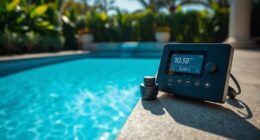Mastering pool alkalinity is crucial for maintaining water quality and pH stability in your swimming pool. Knowing the recommended levels, using the right chemicals for adjustments, and monitoring pH balance are essential steps. Promptly addressing any imbalances ensures a safe and enjoyable swimming environment. By mastering these key tips, you can prevent cloudy water, equipment damage, and chemical inefficiency. Proper maintenance of alkalinity ensures a healthy pool environment. Stay informed on these critical aspects to keep your pool in top condition for the best swimming experiences.
Key Takeaways
- Regularly test alkalinity levels.
- Use appropriate chemicals for adjustments.
- Maintain alkalinity between 80-120 ppm.
- Prevent pH fluctuations and water quality issues.
- Ensure safe swimming environment with proper alkalinity.
Understanding Pool Alkalinity Levels
Understanding pool alkalinity levels is fundamental for maintaining water quality and ensuring proper pH balance in your swimming pool. Alkalinity measures the water's ability to neutralize acids and bases, playing a critical role in stabilizing pH levels.
The recommended swimming pool alkalinity level typically falls between 80-120 parts per million (ppm). By keeping alkalinity within this range, you can prevent pH fluctuations that may lead to water quality issues.
Monitoring alkalinity levels regularly using testing kits is crucial for effective pool maintenance. It is important to address alkalinity imbalances promptly to avoid problems such as cloudy water, equipment damage, or skin irritation.
Proper knowledge and management of pool alkalinity are essential for a safe and enjoyable swimming experience.
Adjusting Alkalinity With Chemicals
Maintaining ideal pool alkalinity levels can be achieved through strategic use of specific chemicals. To increase low alkalinity levels falling below the recommended range of 80-120ppm, sodium bicarbonate, commonly known as baking soda, can be added to the pool. This chemical helps raise alkalinity without significantly impacting pH levels.
Conversely, high alkalinity levels exceeding 120ppm can be reduced using chemicals such as sodium bisulfate or muriatic acid. These substances effectively lower alkalinity levels, aiding in preventing issues like cloudy water and pH fluctuations. It is essential to carefully follow manufacturer instructions and test the water regularly to ensure the desired alkalinity levels are maintained for best pool water quality.
Monitoring Ph Levels for Balance

Proper monitoring of pH levels in your pool is important for maintaining water balance and quality. pH levels indicate the acidity or basicity of the water, affecting the effectiveness of chlorine and overall swimmer comfort.
Ideally, pool pH should be maintained between 7.2 and 7.6 for best performance. Regularly testing pH levels using a reliable testing kit is vital to ensure that the water chemistry remains balanced.
Factors such as rainfall, swimmers' body oils, and chemical treatments can all impact pH levels. Monitoring pH levels allows for prompt adjustments to be made using appropriate chemicals to prevent potential issues such as skin irritation, equipment damage, or inefficient chlorine disinfection.
Addressing Alkalinity Imbalances
To effectively manage alkalinity imbalances in your pool, prompt and appropriate corrective actions are essential.
When facing low alkalinity levels below 80ppm, utilizing sodium bicarbonate, commonly known as baking soda, can help raise alkalinity levels.
Conversely, if the alkalinity is too high, above 120ppm, the use of sodium bisulfate or muriatic acid can bring it back to the ideal range.
High alkalinity levels can lead to cloudy water, surface buildup, and pH fluctuations. On the other hand, low alkalinity may result in green water, skin irritation, and damage to pool surfaces and equipment.
Regular testing and timely adjustments are key to maintaining balanced alkalinity levels for a healthy and clear pool environment.
Importance of Proper Alkalinity Maintenance

Effective management of pool alkalinity is fundamental for maintaining water quality and preventing potential issues that may arise from imbalances.
Maintaining proper alkalinity levels offers several benefits:
- Water Clarity: Sufficient alkalinity helps keep the water clear and free from cloudiness.
- Equipment Protection: Balanced alkalinity prevents corrosion of pool equipment and surfaces, extending their lifespan.
- Chemical Efficiency: Proper alkalinity levels guarantee that other chemicals, like chlorine, work effectively to sanitize the pool.
Frequently Asked Questions
Can High Alkalinity Levels Affect the Color of Pool Water?
High alkalinity levels in pool water can affect the color by causing cloudiness. This is due to the build-up of inorganic materials on pool surfaces. Proper maintenance and balancing of alkalinity levels are essential for clear pool water.
Is It Safe to Swim in a Pool With Low Alkalinity?
Swimming in a pool with low alkalinity can pose risks like skin and eye irritation, as well as damage to pool surfaces and equipment. It's essential to maintain proper alkalinity levels between 80-120ppm for a safe and enjoyable swim.
How Often Should Pool Alkalinity Levels Be Tested?
Regular testing of pool alkalinity levels is crucial for water quality maintenance. It is recommended to test alkalinity levels at least once a week to achieve they fall within the ideal range of 80-120ppm, promoting a balanced pH level for safe swimming conditions.
Can Using Well Water Impact Pool Alkalinity?
Using well water for your pool can impact alkalinity. Well water often has a high pH and contains minerals that can raise alkalinity levels. Regular testing and adjustments with appropriate chemicals will help maintain ideal alkalinity levels in your pool.
Are There Natural Ways to Increase Alkalinity in a Pool?
Natural ways to increase alkalinity in a pool include using baking soda, which is sodium bicarbonate. This compound effectively raises alkalinity levels in a safe and eco-friendly manner. It's important to monitor and maintain alkalinity within the recommended range for best pool water quality.
How does Pool Vacuuming Affect Pool Alkalinity Levels?
When it comes to maintaining the alkalinity levels in your pool, pool vacuuming plays a crucial role. By following the right pool vacuuming tips, you can prevent debris and organic matter from negatively impacting the alkalinity levels. Regular vacuuming helps to keep the water clean and balanced, ensuring a healthy swimming environment.
What role does alkalinity play in maintaining crystal-clear pool water?
Maintaining crystal-clear pool water requires pool water chemical mastery. Alkalinity plays a crucial role in this process, as it helps to stabilize the pH levels of the water. By keeping alkalinity within the recommended range, pool owners can ensure that their water remains clean, clear, and free of harmful contaminants.
What is the Relationship Between Alkalinity and Crystal-Clear Water in a Pool?
The relationship between alkalinity and crystal-clear water in a pool is crucial for maintaining a healthy environment. With proper pool water chemical mastery, balancing alkalinity levels can prevent pH fluctuations and ensure water clarity. This harmonious balance enhances the effectiveness of other pool chemicals, leading to a clean and inviting swimming experience.
Conclusion
Finally, mastering pool alkalinity is essential for maintaining peak water quality and balanced pH levels.
One intriguing statistic to ponder is that about 85% of pool maintenance issues can be linked back to improper alkalinity levels.
By grasping the significance of total alkalinity, fine-tuning levels accurately, and monitoring pH balance effectively, pool owners can guarantee a harmonious aquatic setting for swimmers to relish.
Professional pool servicing can also play a crucial role in preserving proper alkalinity levels for long-term pool integrity.










